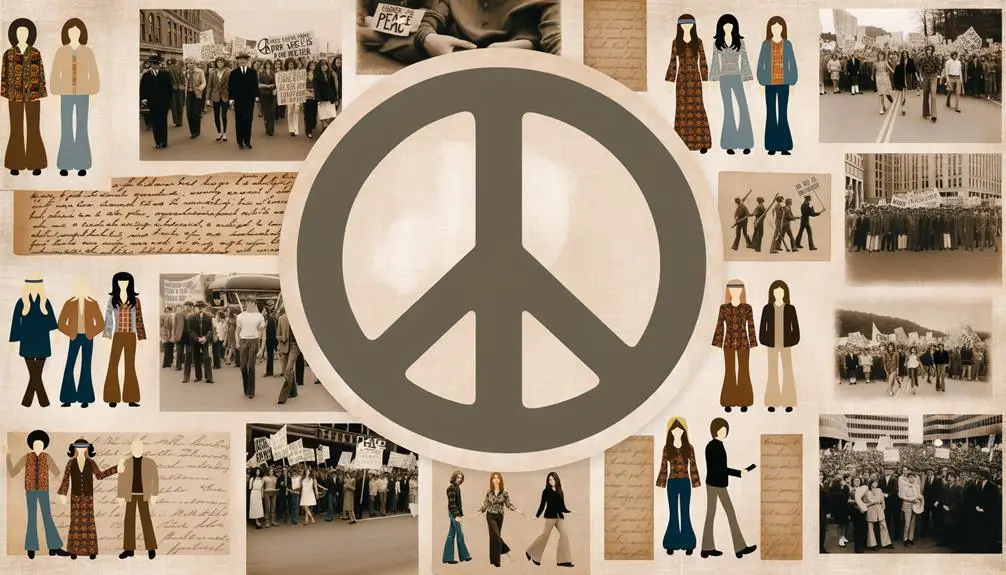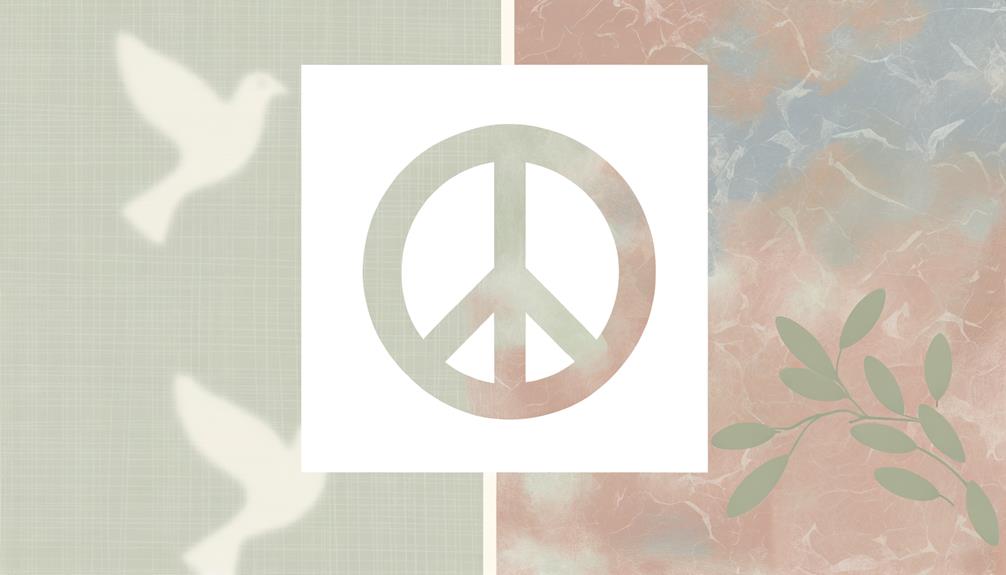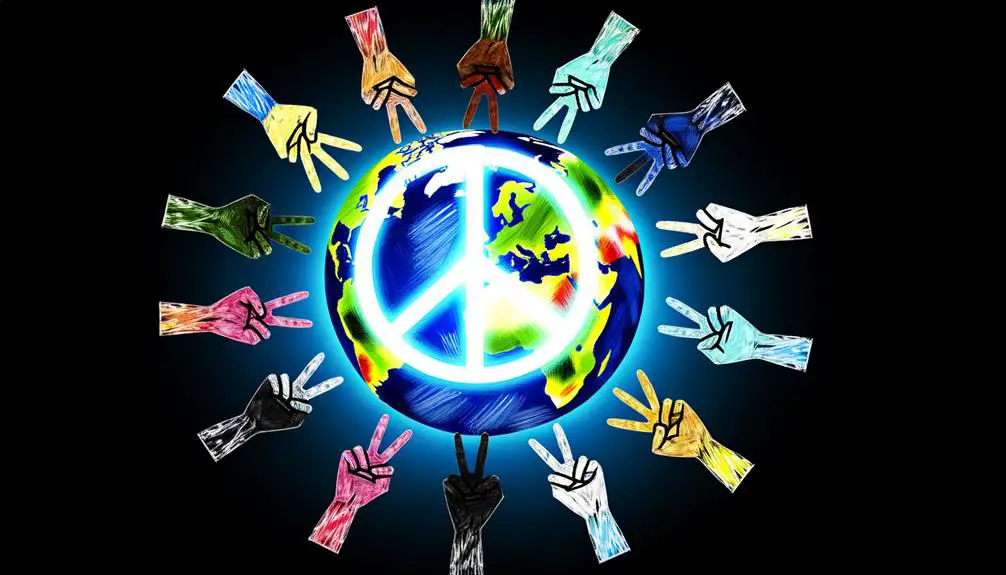What Is the Meaning of the Peace Symbol’s Origin?
The peace symbol, crafted by British artist Gerald Holtom in 1958 for the Campaign for Nuclear Disarmament (CND), initially utilized the semaphore signals for 'N' and 'D.' It first appeared in a public demonstration in April 1958, quickly becoming synonymous with nuclear disarmament advocacy. By the 1960s, the symbol was adopted by various anti-war and civil rights movements worldwide, especially during the Vietnam War protests.
Over time, it has come to signify broader concepts of peace and non-violence across diverse cultures and movements. To comprehend its lasting cultural impact and evolving interpretations, consider exploring its rich history further.

Key Takeaways
- Designed by Gerald Holtom in 1958, it combines semaphore signals for 'N' and 'D' representing nuclear disarmament.
- Initially used by the Campaign for Nuclear Disarmament, it quickly became a universal symbol for peace.
- The peace symbol is synonymous with anti-nuclear, civil rights, and anti-war movements, notably the anti-Vietnam War protests.
- It represents global aspirations for peace and non-violence, transcending cultural and national boundaries.
- Continues to be reinterpreted by contemporary movements, highlighting ongoing efforts for peace and justice.
Origins of the Symbol

Originating in the late 1950s, the peace symbol was designed by British artist Gerald Holtom as a logo for the Campaign for Nuclear Disarmament (CND).
Holtom, drawing from his background in graphic design, aimed to create a symbol that resonated with the growing anti-nuclear movement. Primary sources, including Holtom's personal letters, reveal that he was deeply influenced by the existential threat posed by nuclear weapons.
Chronologically, the symbol first appeared in a public demonstration on April 4, 1958, during a march from London to the Atomic Weapons Research Establishment at Aldermaston.
The adoption of the symbol by the CND marked a pivotal moment, embedding it in the broader context of 20th-century social movements advocating for peace and disarmament.
Design and Semantics

The design of the peace symbol, created by Gerald Holtom in 1958, was inspired by the semaphore signals for the letters 'N' and 'D', standing for 'nuclear disarmament.' Initially adopted by the British Campaign for Nuclear Disarmament, this symbol has since undergone various interpretations, reflecting broader anti-war and peace movements.
Its cultural impact has been profound, evolving from a specific protest icon to a universal emblem of peace.
Origins and Inspiration
Gerald Holtom, a British graphic designer, created the peace symbol in 1958 as part of the nuclear disarmament movement. Holtom's design was intended for the Campaign for Nuclear Disarmament (CND) march from London to Aldermaston.
According to primary sources, Holtom combined the semaphore signals for the letters 'N' and 'D,' standing for 'nuclear disarmament.' The symbol consists of a circle with a vertical line and downward-facing lines on either side, resembling a human with arms outstretched in a gesture of despair.
Holtom described this imagery as reflecting his personal anguish and desperation over nuclear weapons. The finished design was immediately adopted by the CND and quickly became an enduring symbol of peace and anti-war movements globally.
Symbolic Interpretations
Frequently analyzed for its profound simplicity, the peace symbol's design combines both visual elements and underlying semantics that convey powerful messages of unity and nonviolence. Originating in 1958 by Gerald Holtom, this iconic symbol integrates semaphore signals for 'N' and 'D' (Nuclear Disarmament). The vertical line represents the semaphore signal for 'D' while the downward lines form 'N'. Holtom's design is not just a visual amalgam but a semantic representation intended to evoke a universal plea for peace.
| Design Element | Semaphore Meaning | Semantic Interpretation |
|---|---|---|
| Vertical Line | 'D' (Disarmament) | Call for nuclear disarmament |
| Downward Lines | 'N' (Nuclear) | Opposition to nuclear weapons |
| Circle | Enclosure of elements | Unity and global inclusivity |
| Empty Space | Simplicity | Clarity of purpose |
| Overall Design | Combined Semaphore | Thorough peace message |
Cultural Impact
Holtom's design, while rooted in specific semaphore signals, quickly transcended its original context to become a global emblem of peace, deeply influencing both cultural movements and individual expressions across decades.
Initially created for the Campaign for Nuclear Disarmament in 1958, the symbol was rapidly adopted by the broader peace movement. Throughout the 1960s and 70s, it became synonymous with anti-war protests, civil rights activism, and countercultural expressions, as documented in periodicals and protest photography of the time.
The peace symbol's simplicity and potent meaning facilitated its integration into fashion, art, and music. By the late 20th century, it had become an enduring icon, illustrating a universal longing for harmony and nonviolence, as evidenced by its continued presence in global peace initiatives.
Early Adoption

The early adoption of the peace symbol can be traced back to its initial use during the Campaign for Nuclear Disarmament (CND) marches in the late 1950s. Designed by Gerald Holtom in 1958, the symbol quickly became synonymous with anti-nuclear activism. Its first public appearance was during the Aldermaston March, where it was prominently displayed on banners and placards.
Primary sources from the period chronicle its rapid acceptance and widespread usage among activists.
Key moments include:
- 1958: Introduction of the symbol at the Aldermaston March.
- 1959: Incorporation in CND publications and promotional materials.
- 1960: Embrace by student groups and left-wing organizations.
- 1961: Symbol integration into broader civil rights movements.
This early adoption laid the groundwork for its enduring legacy.
Global Impact

As the peace symbol gained momentum in the 1960s, its influence transcended national borders, becoming a universal emblem adopted by diverse movements around the world.
Originating from the British Campaign for Nuclear Disarmament, the symbol quickly found resonance in the United States' anti-Vietnam War protests. Archival footage from the era shows its widespread use in rallies and demonstrations.
Symbol in Activism
In the domain of activism, the peace symbol has served as a powerful visual tool, galvanizing movements and amplifying their messages across decades. Initially introduced during the anti-nuclear weapons movement in the 1950s, the symbol's influence rapidly spread. By the 1960s, it became synonymous with the civil rights and anti-Vietnam War movements, as documented in various protest photographs and media coverage. Primary sources from these periods highlight the symbol's pervasive presence.
Key eras of activism featuring the peace symbol:
- 1950s: Anti-nuclear weapons movement
- 1960s: Civil rights and anti-Vietnam War movements
- 1980s: European anti-nuclear protests
- 2000s: Global anti-war and environmental activism
This chronological journey underscores the symbol's enduring potency in rallying collective action.
Cultural Representations

While rooted in activism, the peace symbol has permeated various cultural mediums, reflecting and shaping societal values throughout different historical periods.
Initially conceived in 1958 for the Campaign for Nuclear Disarmament, its adoption by anti-war movements in the 1960s broadened its cultural resonance. Photographs and posters from that era, such as those by Marc Riboud, illustrate its ubiquity in protest art. The symbol migrated into music, fashion, and visual art, with notable appearances in works by John Lennon and Yoko Ono.
During the 1970s and 1980s, it was emblazoned on clothing and merchandise, signifying countercultural ideals. By the 1990s, the peace symbol had become a global icon, featured in various media, from street art to commercial branding.
Modern Interpretations

Modern interpretations of the peace symbol reflect its evolution from a protest emblem to a versatile icon embedded in contemporary social and political discourse. Initially adopted in the 1950s by the Campaign for Nuclear Disarmament, its meaning has expanded over the decades.
Primary sources from the 1960s show its association with the anti-Vietnam War movement, while the 1980s saw it embraced by anti-nuclear activists. Today, the symbol is widely recognized, signifying broader themes of global peace and unity.
Its usage spans various contexts, including:
- Environmental activism: advocating for ecological harmony.
- Digital movements: symbolizing online solidarity and cooperation.
- Fashion and art: representing a universal desire for peace.
- Educational initiatives: teaching non-violence and conflict resolution.
In each era, the peace symbol has adapted to reflect contemporary issues and values.
Conclusion
The peace symbol, evolving from its origins to a global emblem, mirrors the journey of the olive branch in its quest for universal harmony.
Initially a protest against nuclear armament, its design and semantics transcended national borders, becoming a cornerstone of activism and cultural expression.
Modern interpretations continue to reflect its enduring significance, akin to the perpetual relevance of the dove in literature, symbolizing the everlasting human aspiration for peace and unity.






